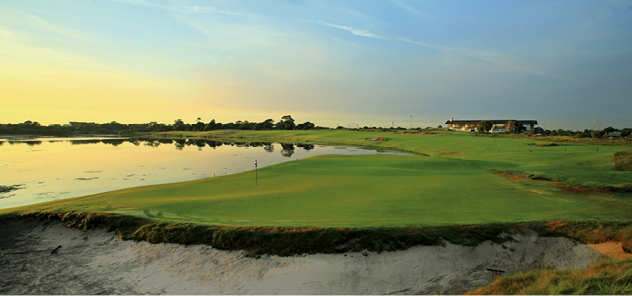
The Lakes is one of Sydney’s iconic golf courses, a regular venue for big championships – including the Australian Open – during its 82-year history. Yet since the late 1960s, when the course was forced into a redesign, constant tinkering with holes has gone on in the search for something better. The latest redesign has finally delivered.
The original course was bisected in 1968 by the airport freeway. American architect Robert von Hagge, in partnership with Bruce Devlin, created a new course with holes laid out either side of the road. It was an almost treeless site, exposed to the wind. The new holes, especially those on the back nine, stretched dramatically around and across some huge lakes, a significant part of the character of both the old and new courses.
Over the ensuing years the course, and its character, changed. Hundreds of non-native trees – mostly pines – were planted. They grew to frame the fairways and rob The Lakes of its open, links-like feel. A string of designers made their mark during the 1980s and ’90s. Then in 2006 the club commissioned Mike Clayton to restore the course to its previous look and feel. The open, sandy wastelands of the original course had long since disappeared under the trees. ‘While it could never have been described as a parkland course,’ says Clayton, ‘it was closer to a park than ever before.’
The clearing of the land is the most obvious visual change since then. Clayton has opened up vast tracts of the course that were for decades hidden by trees and scrub. Now, from some tees, you can see the Sydney city skyline. The clearing program has also widened the playing lines. Mis-hits are no longer gobbled up by scrub, forcing a penalty upon the player. Instead you must fashion a recovery from long grass or an uneven, sandy lie.
Clayton’s work has brought a new lease of life to The Lakes, especially the front nine holes, which were always criticised for being nowhere near as good as the spectacular back nine. The gap has closed significantly.
The 2nd, for instance, shortened from a par-five to a 400-metre par-four, is a much-improved hole. Now longer hitters can hit their drives up the rise, earning themselves a clear view of the surface of the green as well as the flagstick. The fairway has been widened; it’s almost impossible to miss left. Players who position themselves away from the wasteland flanking the right edge of the short grass are faced with a longer shot to the green, but they will be approaching on a good angle, for the green sits diagonally left to right. A deep swale in front protects the right half of the green – the narrowest and most difficult part to access.
There remain many highlights on the back nine, starting with the short par-four 10th, which can be played in numerous ways depending which way the wind is blowing. Then come the three par-fives – the 528-metre 11th, the 502-metre 14th and the 454-metre 17th. All three offer the chance of a birdie, or even an eagle, if the conditions are right and you are prepared to take a risk from the tee. The drives on all three must skirt a hazard to shorten the hole and bring the green in range for your second shot. It is a huge risk, as some of the world’s best players have discovered: a 10, 11, or 12 can be just as easily scored on these holes as a birdie or par. So it is with many holes on the new Clayton-designed Lakes layout.
The Lakes is a private club, but restricted tee times are available for visitors who are members of a club.
|
MEMORABLE HOLES 2nd, 4th, 8th, 10th, 11th, 14th, 16th and 17th WHERE TO GO King St, Mascot, NSW 2020 BOOK A ROUND (02) 9669 1311, www.thelakesgolfclub.com.au OTHER 120 GREAT COURSES NEARBY The Australian (2.4 km), St Michael’s (10.3 km), New South Wales (10.3 km), Royal Sydney (12.6 km) WHERE TO STAY The Lakes is 15 minutes’ drive south of Sydney’s CBD, which has accommodation options to match all budgets. BEFORE/AFTER YOUR ROUND Spend an afternoon walking around the attractions of Darling Harbour: the huge Sydney Aquarium, the eight-storey IMAX theatre and the Australian Maritime Museum. |
